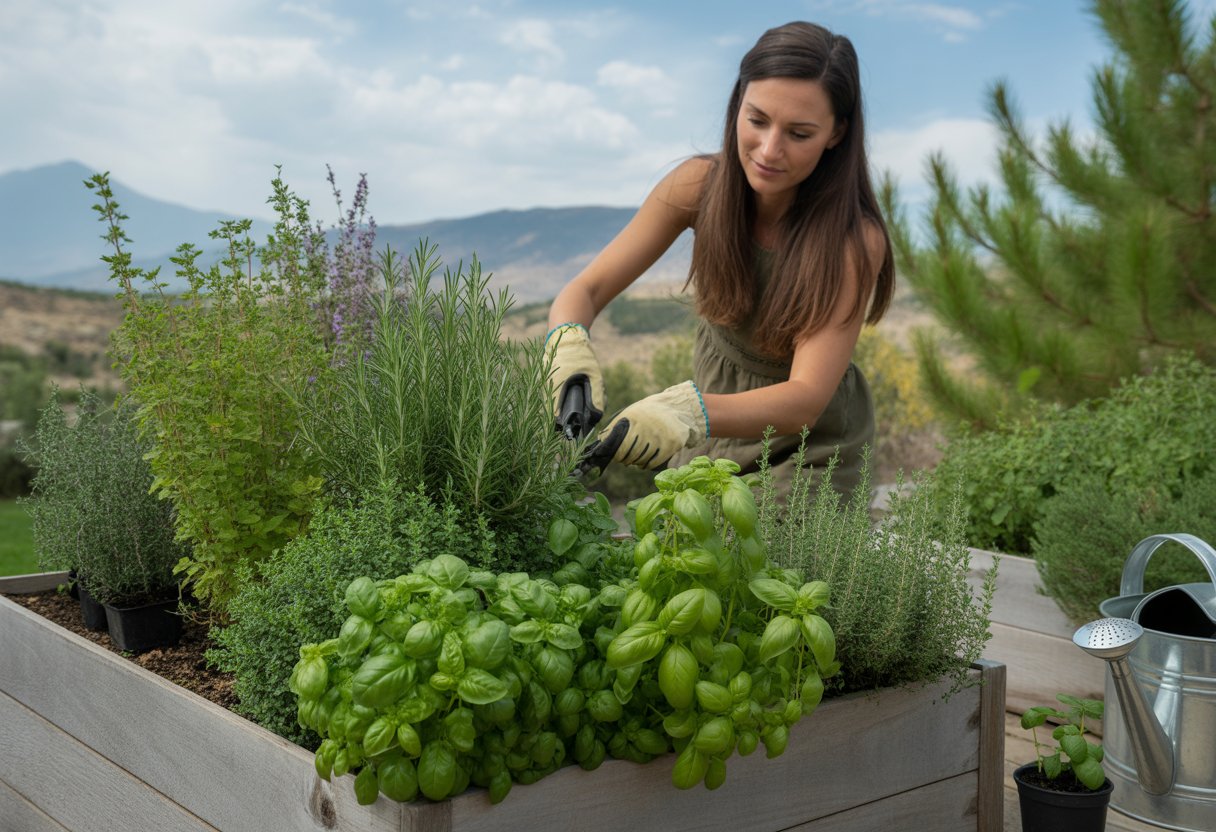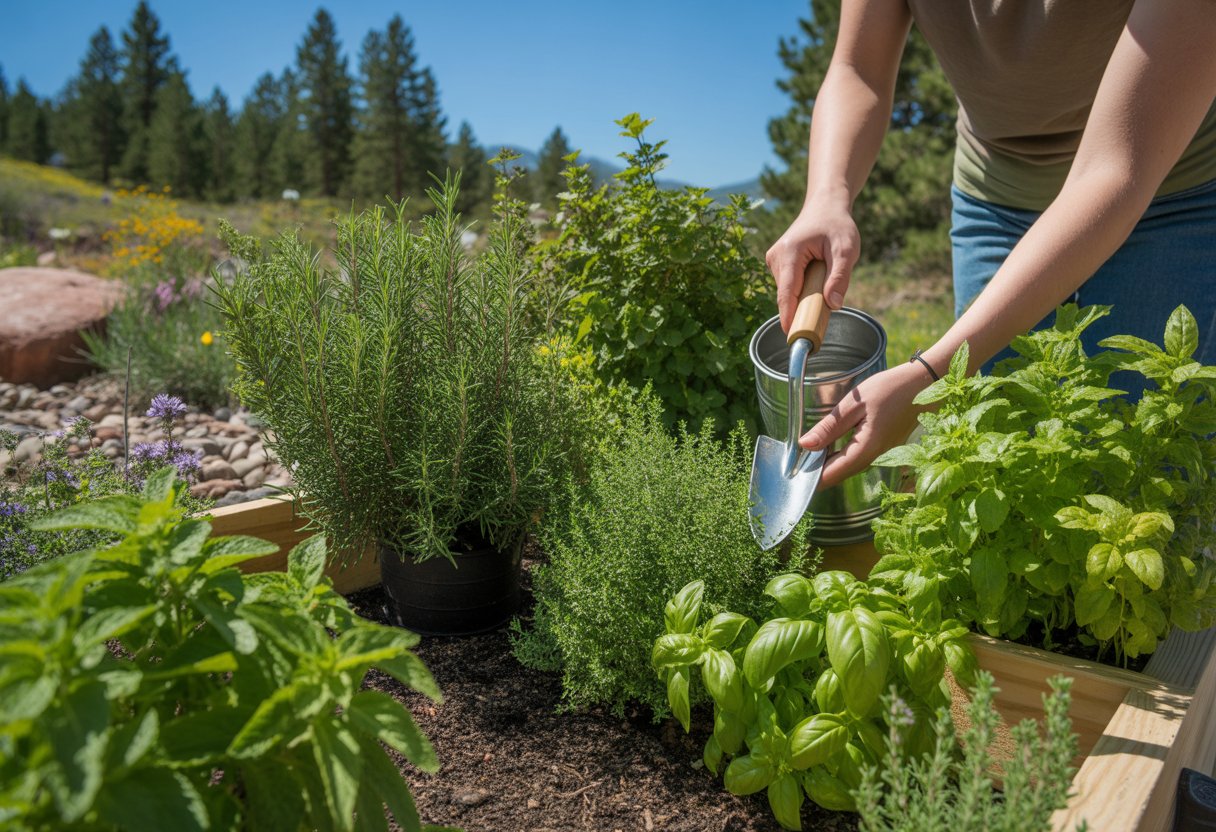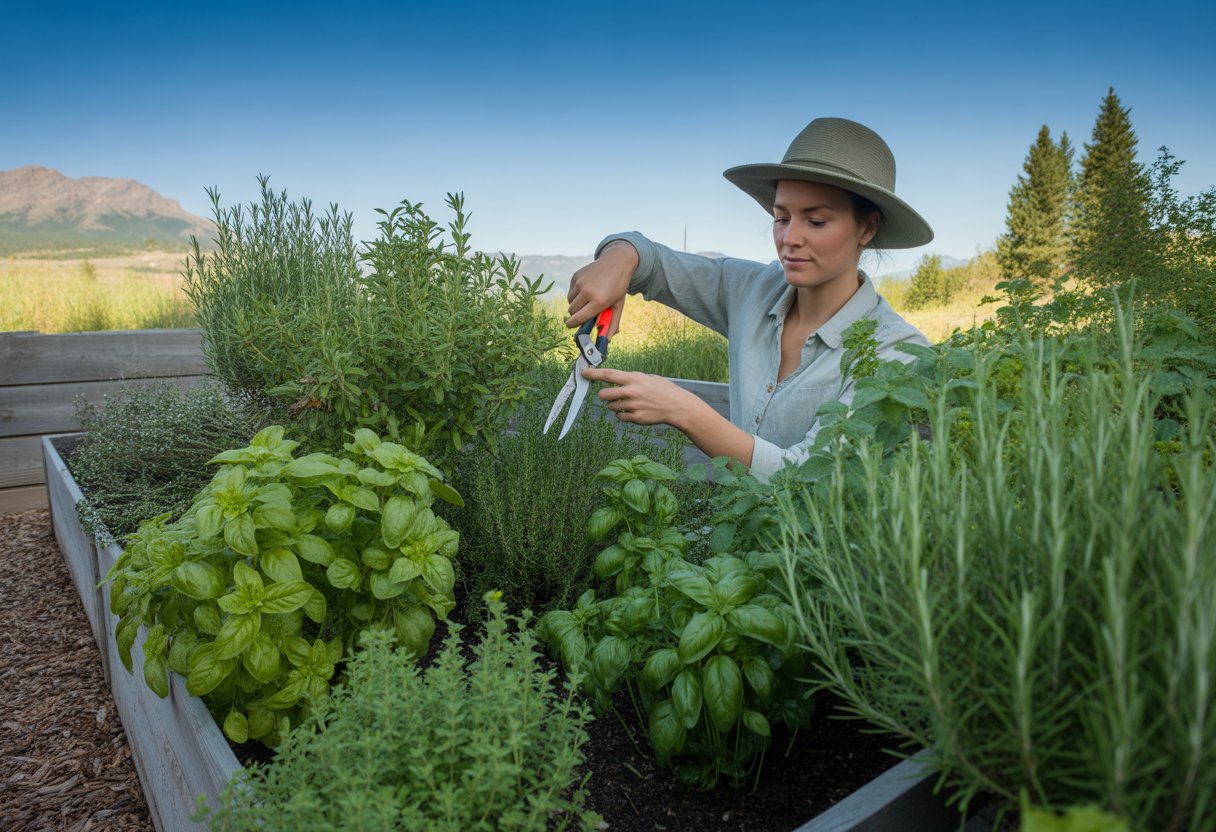Herb Gardening Tips for Colorado: Essential Advice for Thriving Herbs in Rocky Mountain Climates
Growing herbs in Colorado means getting familiar with its tough climate and tricky soil. High altitude, low humidity, and wild temperature swings can make things challenging.
Choosing drought-tolerant herbs and optimizing soil drainage are key to successful herb gardening in this region.

Pick native or well-adapted herbs like oregano, thyme, and chives. These plants handle Colorado’s environment without much fuss.
Regular watering and a good layer of mulch help keep moisture in and roots happy. It’s a simple trick, but it works.
If you adjust planting times to dodge late frosts and give some shade during those blazing afternoons, your herbs will thank you. Even in Colorado’s unpredictable weather, these steps really help.
Understanding Colorado’s Unique Gardening Climate
Colorado’s climate, soil, and water situation shape how you garden. You’ll need to tweak your approach to soil prep, watering, and choosing suitable herbs for your space.
Regional Microclimates and Elevation
Colorado’s elevation swings wildly, from 3,300 up to 14,000 feet. Higher spots stay cooler and have shorter growing seasons, which can stress many herbs.
Microclimates pop up everywhere—sun exposure, wind, and even city heat can make a difference. South-facing slopes, for example, warm up early and suit basil or rosemary.
Choose herbs that match your specific zone. Cooler areas? Chives and mint work. Warmer spots? Go for thyme and oregano.
Wind can be brutal, so set up barriers for delicate herbs if your garden’s exposed.
Soil Quality and Preparation
Colorado soils often lack organic matter and key nutrients like nitrogen, phosphorus, and potassium. That’s not great for herbs unless you fix it.
Toss in compost or aged manure to boost organic matter and help the soil hold together. Checking soil pH is smart—Colorado soils tend to be alkaline (7.5+), but most herbs like it a bit more acidic or neutral (6.0-7.0).
Go for light, well-draining soil to keep roots healthy. If you’re dealing with clay or sand, mix in amendments so water doesn’t pool or run off.
Watering Considerations
Low humidity and strong sun dry things out fast. Deep watering once or twice a week beats frequent light sprinkles.
Mulch helps keep moisture in and soil temps steady. Drip irrigation is handy—it gets water right to the roots without much waste.
Check soil moisture often. Too much water causes fungus, but too little stunts growth. Change your watering routine with the seasons, your elevation, and what you’re growing.
Selecting the Best Herbs for Colorado Gardens
Colorado’s wild weather means you need herbs that can handle big temperature swings, dry spells, and intense sun. Picking the right varieties and knowing their quirks makes a huge difference.
Choosing Cold-Hardy and Heat-Tolerant Varieties
Winters get cold, summers get hot—herbs need to handle both. Perennials like thyme, sage, and rosemary shrug off the cold.
Hardy annuals like basil and oregano might need some cover during cold snaps or work best as summer crops. Heat tolerance is a must since the midday sun can be brutal.
Mulch and regular watering help, but starting with tough varieties saves headaches.
Herbs That Thrive in Colorado
Thyme, sage, and oregano love Colorado’s soil and weather. They need well-drained soil and lots of sun, and they don’t mind dry stretches.
Mint grows like crazy—sometimes too crazy. It prefers cooler, shady spots and plenty of water, so pots help keep it in check.
Basil likes warmer temperatures and can struggle at the start or end of the season. Starting seeds indoors or picking up seedlings gives you a jump on the short growing period.
Growing Basil, Oregano, and Mint
Basil thrives in Colorado’s warmest months. Plant after the last frost in rich, well-drained soil and make sure it gets at least 6 hours of sun.
Water it regularly, but don’t drown it. Oregano handles drought once established and soaks up the sun.
It doesn’t need much water, and you can harvest it all season. Mint wants partial shade in hot areas to avoid crispy leaves.
Keep mint contained and water it well for lush growth.
Cultivating Rosemary, Sage, and Thyme
Rosemary hates cold winds, so plant it near a wall or mulch it well. It needs sun and well-drained soil.
Sage handles cold and drought. Sandy or loamy soil and full sun suit it best.
Prune sage to encourage a bushier plant. Thyme grows in rocky or poor soil and doesn’t mind the cold or heat.
Harvest thyme often to keep it growing strong. Give it good air circulation to avoid mildew.
Building and Maintaining a Healthy Herb Garden

A healthy herb garden takes some planning—think soil, space, and pest control. Smart design and regular care keep herbs thriving, even with Colorado’s pests and surprises.
Planning Raised Beds
Raised beds make life easier by improving drainage and keeping soil temperatures steady. Aim for at least 12 inches deep so roots have room.
Use well-draining, nutrient-rich soil with compost for herbs like basil, thyme, and parsley. Set up raised beds where they’ll get at least 6 hours of sunlight.
Group herbs with similar watering needs. Add paths so you can water, harvest, and weed without trampling plants.
Companion Planting Strategies
Companion planting helps herbs grow and keeps bugs away. Marigolds near tomatoes, beans, or lettuce can drive off aphids.
Onions and garlic protect carrots, beets, and radishes from pests. Peas and beans add nitrogen, which helps cabbage and broccoli.
Don’t plant celery near carrots and dill—they fight for nutrients. Companion planting boosts plant health and keeps your garden diverse.
Managing Garden Pests
Aphids, caterpillars, and mites love herbs and veggies. Plant marigolds and onions to naturally repel insects.
Hand-pick bigger pests like caterpillars or use insecticidal soap if things get bad. Rotate crops each year to dodge soil diseases.
Keep the garden tidy by clearing dead leaves and debris. Bring in ladybugs—they’re great for controlling pests.
Seasonal Care and Harvesting Techniques

Colorado gardeners deal with wild temperature swings and need to handle herbs right for the best flavor. Protecting plants from frost and knowing when to harvest really matters.
Preparing for Early and Late Frosts
Colorado’s growing season is short, and frost can sneak up on you. Keep an eye on local frost dates and have frost blankets or row covers ready.
These covers shield herbs like basil, cilantro, and parsley from sudden chills. Bring potted herbs inside before frost hits, or at least move them somewhere sheltered.
Mulch around thyme and sage to keep soil warm and moist overnight. Prune herbs before frost to encourage spring regrowth, but don’t cut too low—cold-stressed plants need all the help they can get.
Proper Harvesting and Storage
Harvest herbs early in the day, right after the dew dries. That’s when you’ll get the highest concentration of essential oils.
Grab some clean, sharp scissors or pruning shears to snip your herbs. Avoid tearing or crushing the stems—nobody wants bruised leaves.
If you’re working with perennial herbs like rosemary or oregano, try picking the new growth. This encourages the plant to keep producing.
Hang small bunches of herbs upside down in a dark, airy spot. It’s a classic move that helps keep their color and flavor intact.
Or, if you’re feeling practical, chop them up and freeze the bits in ice cube trays. Toss those cubes into your cooking whenever you need a burst of freshness.
Store dried herbs in airtight, opaque containers. Keep them away from sunlight and heat—herbs fade fast if you don’t.
Stick a label with the date on each container. It’s easy to forget how long those jars have been sitting around.


